Brooklyn – First Dutch Cemetery (disappeared)
After the successful establishment of a Dutch colony on the southern tip of Manhattan, the first regular church services were held in 1628 in the fort Nieuw Amsterdam. This happened in a room of the grain mill that the colonists had built here. In 1633, the first wooden church was built near the banks of the East River.
In the early years, the settlers developed a lot of land on the island of Manhattan and on the shores of nearby islands, such as ‘het Lange Eiland’ (now Long Island). The land was 'bought' in a simple way from the indigenous tribes that lived there. The purchase was often with goods and not with money. In the decades that followed, numerous settlements were established on Manhattan and Long Island. Among them in 1646 on Long Island the village of Breuckelen, where in that area some farms had already been built. Also at the location where the ferry across the East River docked from Manhattan, a small settlement soon arose (now the end of Old Fulton Street).
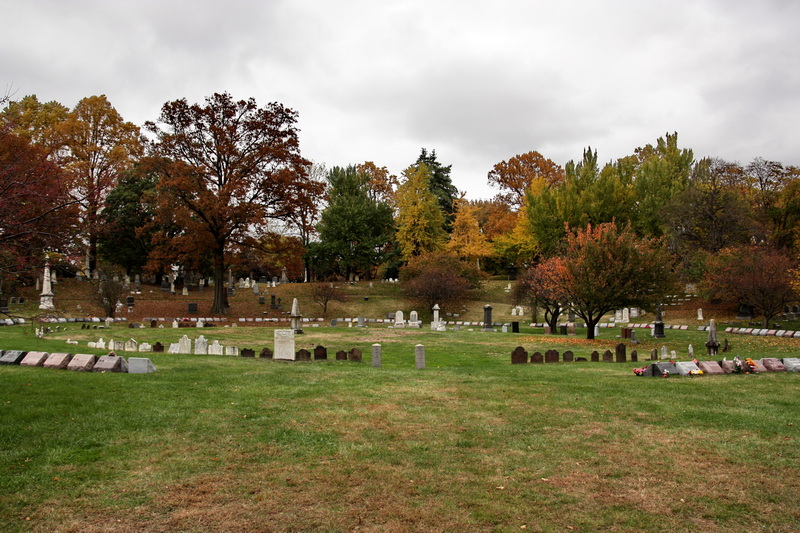 Brooklyn Cemetery Graveyard Arrangement at Cedar Dell at Green-Wood-Cemetery.
Brooklyn Cemetery Graveyard Arrangement at Cedar Dell at Green-Wood-Cemetery.
For a long time, the inhabitants of the western part of Long Island were dependent on Nieuw Amsterdam. From an ecclesiastical point of view, this lasted until 1654. In that year the inhabitants of the villages on Long Island got their own reverend, in this case Johannes Theodorus Polhemius (1598-1676). Polhemius mainly served the villages of Vlackebos or Midwout (Flatbush) and Nieuw Amersfoort (Flatlands). The inhabitants of the smaller Breuckelen had to improvise in the first years. The reverend was German by birth, but married to a Dutch wife and by chance he had ended up in the Dutch colony via Brazil. For the small villages on the Long Island, the reverend was a godsend. In April 1656 he preached for the first time in Breuckelen and that year is seen as the official beginning of the church of Breuckelen. It was not until 1660 that Breuckelen got its own reverend: Henricus Selijns (1636-1701) and in 1666 the first church in Breuckelen was built. That was at the current Fulton Street between Lawrence and Bridge Streets.
The cemetery
The first burials in Breuckelen took place before there was a church. It will not always have been easy to bring the dead to the existing cemeteries in Nieuw Amsterdam. Moreover, it was costly and dangerous. It is likely that the church was built next to the cemetery. Later descriptions indicate that there was a road between church and cemetery. The cemetery was indicated in the seventeenth century as 'about half an acre of ground' in size. That is about 2,000 m2 in size. Little has been recorded about how the cemetery was used.[1]
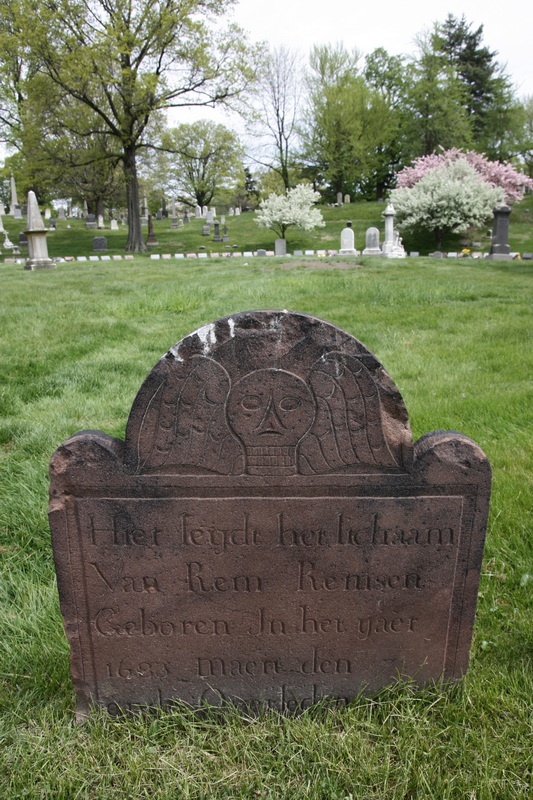 Gravemarker in sandstone for Rem Remsen (1683-1752) with a classical winged skull.
Gravemarker in sandstone for Rem Remsen (1683-1752) with a classical winged skull.
This made it the first European cemetery on Long Island in addition to the already existing indigenous cemeteries. Just south of the village of Breuckelen, at Freeke's mill on the Gowanus creek was such a cemetery. The later owners of the land did not deal with this cemetery in a very good way. [2] Today, nothing remains of such cemeteries. In Brooklyn today, however, new construction projects occasionally come across traces of old burials during excavations. For example, excavations near the Flatlands cemetery showed that earlier graves belonged to indigenous tribes.[3]
Arrival of the English
After the Dutch colony was taken over by the English in 1664, not much changed in the church itself. It remained under the reformed congregation of Amsterdam in the Netherlands and the language remained Dutch for a long time. In the church and in the cemetery, the Dutch language was audible and visible until the end of the eighteenth century, after which English became the language of instruction and writing. Until 1920, however, there were still small Dutch enclaves in Brooklyn. Most of the names were now anglicized, such as Breuckelen to Brooklyn and het Lange Eiland to Long Island.
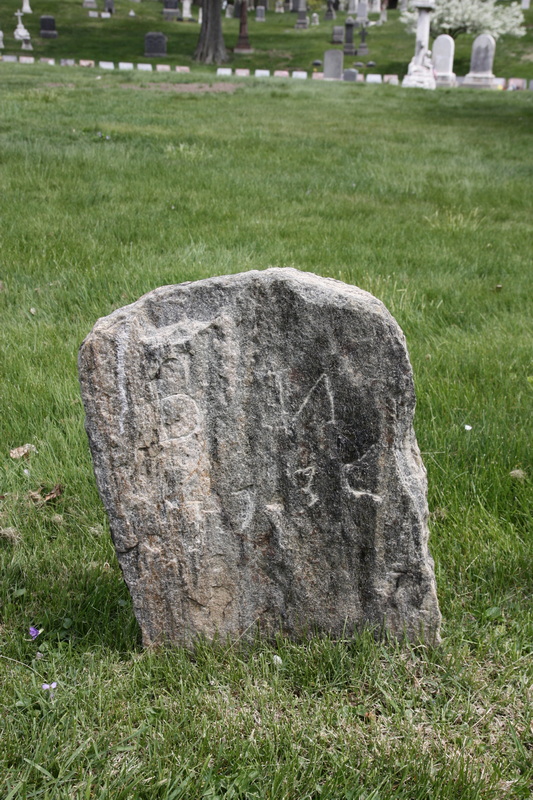 One of the oldest tombstones of the cemetery; a simple piece of schist or fieldstone from the first half of the eighteenth century.
One of the oldest tombstones of the cemetery; a simple piece of schist or fieldstone from the first half of the eighteenth century.
A big change though was the inheritance law. In the Dutch colony, women were as entitled to a share of the inheritance as the men. Among the English, such a division was not allowed, but the Dutch managed to take advantage of their situation and to control it. However, much land eventually fell into the hands of English families and by marrying among themselves, the Dutch names gradually faded into the background.
In 1776, the Dutch Reformed Church of Brooklyn had a new church built, possibly expanding the cemetery. As early as 1805 Brooklyn had grown to such an extent that a larger church was needed. In 1807 a new church was built at a different location and only the cemetery remained. The old church was demolished not long after, which gave the space for the later Fulton Street.
End of the cemetery
As Brooklyn grew, the graveyard's future became increasingly uncertain. In 1840, Green-Wood Cemetery [link] was laid out south of Brooklyn. This cemetery not only offered all the space for the deceased in Brooklyn, but also those of Manhattan. From 1849, the municipality of New York also no longer allowed the use of the cemeteries in the increasingly busy city. The church had little trouble with this because selling the land would yield a lot of money. In 1864, a committee was appointed with the purpose of buying land on Green-Wood. The Dutch Reformed Church of Brooklyn could continue to offer its own members a cemetery with this land. In February 1865, the committee reported that they could purchase a piece of land at Green-Wood known as Cedar Dell.[4] It involved a total of 45 pieces of land of more than 4 by 8 meters for which the church paid $ 110 per piece, a total of $ 4,950. The committee was given permission to make the purchase and then have the remains of the cemetery transferred. All this to be paid from the proceeds of the sale of the land of the cemetery. Apparently the evacuation of the old cemetery took some time, because the land was not sold until April 1869. The buyer was Andrew S. Wheeler who paid $112,000 for the land. Wheeler saw an opportunity to realize a five-story luxury retail building on site. Although still far from the heart of Brooklyn at the time, the location had a future through the construction of the Brooklyn Bridge. With the establishment of an Abraham & Straus department store, the building became a success and the entire block between Fulton and Livingston Street was built on, leaving all references to church and cemetery gone forever.
Remains of the cemetery on Green-Wood
The portion purchased by the Reformed Church of Brooklyn was called the "Old First section". The old tombstones that had been transferred from Fulton Street were placed here in a circle, close together. New graves were later issued around it. After the first purchase, the Reformed Church purchased more than 700 grave sites at Green-Wood, all of which are now in use.
In 2009, the board of Green-Wood already looked at the circle, because research - in which a Dutch funerary expert was also involved - showed that things were not going well with the gravestones. Most of them turned out to be far too deep in the ground, causing damage while most texts were not even visible. In the course of 2009, a large number of stones were lifted, but not all. That turned out to be too costly. When the stones were lifted, surprising texts and also images emerged. It turned out that there were more stones to be found with a Dutch text, such as those of Rem Remsen (1685-1752) and several of his family members. The family names of the individuals buried here are easily placed in Brooklyn's history through the names of streets or neighborhoods. Here too we find the grave of Simon Boerum (1724–1775) and his wife Maria Schenck (1725-1771). Boerum was one of the members of the U.S. Continental Congress that was the prelude to the War of Independence. Boerum-Hill is a part of Brooklyn named after the family.
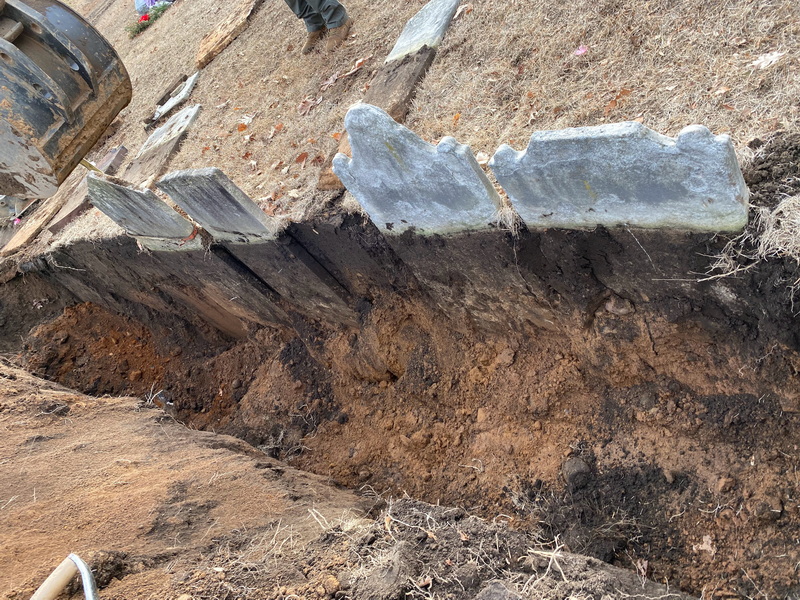 Before the start of the renovation of Cedar Dell, all tombstones were removed from the ground. Some were so putt in so deep that they could only be removed with large equipment (photo Neela K. Wickremesinghe).
Before the start of the renovation of Cedar Dell, all tombstones were removed from the ground. Some were so putt in so deep that they could only be removed with large equipment (photo Neela K. Wickremesinghe).
The dozens of tombstones generally show a strong weathering. The oldest stones, of which only two specimens can be found, consist of schist or ordinary fieldstone. On one of them you can still see the date 1734 with the initials D.N.. Later tombstones, also dating from the eighteenth century, are more often made of brown sandstone. While some of them still contain an easy-to-read text, others are greatly affected and there is nothing readable at all. Funerary monuments from the first half of the nineteenth century are predominantly of a white limestone, resembling marble. Here, too, a great diversity in weathering is visible. In most cases, the stone is still fairly intact but the text has completely disappeared. In the cemetery of Brooklyn, which disappeared from the streets in the middle of the nineteenth century, there were two types of funerary monuments, all stelae. The shape differences between the sandstones and the marble stelae are also striking. The sandstone stelae generally have a termination with arch shapes and acroteria, whether or not stylized. Many of the marble stelae have a straight termination or have a faint round arch. Only a small part has a similar shape.
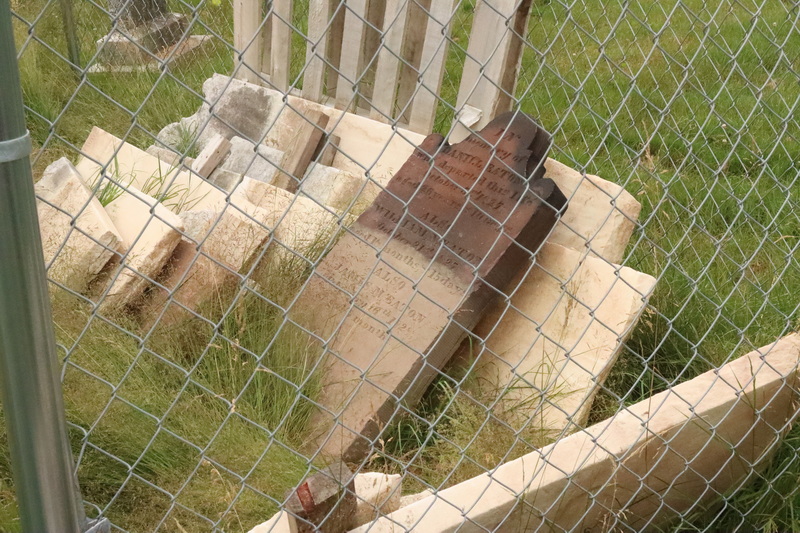
The collection of stelae contains hardly any symbolism. Occasionally, such as on the stones for Elizabeth Smith (undated) and some stones for the Remsen family, an angel's head occurs. Another striking stone is for Cortland Hempstead, chief engineer of the paddle steamship "Lexington". On 13 January 1840, a fire started on this luxury passenger ship in which 139 of the 143 people on board drowned. The ship was on its way in the Long Island Sound at the time. Drawings were made of the fire that was visible from the shore. The drawings were published not long after. An example of such an image of the burning ship is depicted on the tombstone for Cortland Hempstead. Hempstead was 33 years old, but whether he was born in Brooklyn or lived there is not known.
Sale of Cedar Dell
When in 2017 the Reformed Church of Brooklyn put forward the idea of selling the old part of the land on Green-Wood to finance a restoration of the church, it was well received by the Green-Wood board. They were already looking for more space for new graves. However, when the sale of the land was arranged in 1865, the deed stated that repurchase by the board of Green-Wood would take place on the same terms and costs, including interest. After 150 years, that total amounted to $40,000, not enough to pay for the restoration they had planned. After consultation, an arrangement was reached that was beneficial for both parties. It was agreed that the funerary monuments of the old cemetery would be placed back in their old way.
In 2019, Nelson Byrd Woltz Landscape Architects made a plan to redecorate Cedar Dell. The assignment included not only a redesign, but also the task of being able to continue to use the space for performance arts. Together with a more accentuated entrance for the valley , space has also been created for 200 new graves, scattering of ashes and preservation of the historic funerary monuments. The circular shape continues to play an important role in the design, but the valley is also made more shady and attractive, not forgetting the access to the circle.
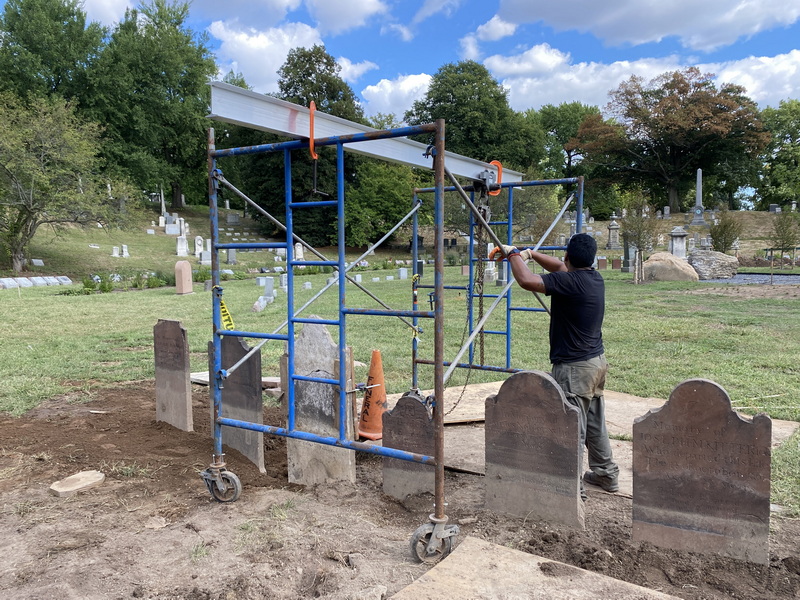
above the ground as possible (photo Neela K. Wickremesinghe)
In the plan for the redevelopment that the board of Green-Wood subsequently carried out, interesting things came to light again about the old stones. Many tombstones were so deep in the ground that normal removal was almost impossible. By digging a deep trench behind the funerary monuments, the stones could be released. Even in places where there seemed to be no funerary monuments, stones or remains of them came up. Some stones turned out to have been restored earlier and some needed repairs. These were taken care of by the curator of Green-Wood.
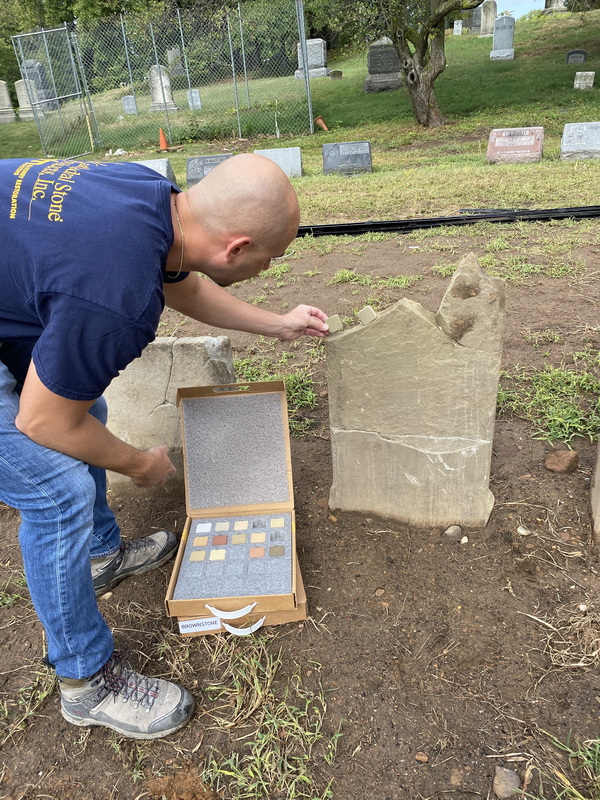
By the end of 2022, all the old gravestones from Brooklyn's old cemetery should be back in place.
Thanks to Neela K. Wickremesinghe, Architectural Conservator Green-Wood
Header: Print after a drawing of the Church of Brooklyn in 1776 by Elizabeth Sleight (Collection Brooklyn Museum).
Notes
- Page 14 in: “History of the First Reformed Protestant Dutch Church of Breuckelen”
- https://www.thelmagazine.com/2011/11/historical-map-reveals-location-of-brooklyns-native-american-burial-ground/
- https://nycemetery.wordpress.com/tag/brooklyn-cemeteries/
- Many sources also speak of 1860 as the year of the purchase of the land.
Literature
- The First Reformed Church of Brooklyn (ed.): History of the First Reformed Protestant Dutch Church of Breuckelen: Now known as The First Reformed Church of Brooklyn, 1654-1896, 1896
- Stiles, Henry R.; A History of the city of Brooklyn, including the old town and village of Brooklyn, the town of Bushwick, and the village and city of Williamsburgh, Brooklyn 1867: https://www.panix.com/~cassidy/stilesv1/v1c1/TOC2.html
- Wickremesingh, N.; Cedar Dell Existing Conditions Survey, September 2016
Internet
- The Cedar Dell at Green-Wood Cemetery:
https://www.nbwla.com/projects/boards/cedar-dell-green-wood-cemetery (accessed 2 August 2022) - Old First Sells Plots Back To Green-Wood Cemetery:
https://oldfirstbrooklyn.org/2017/06/22/old-first-sells-plots-back-to-green-wood-cemetery/ (accessed 2 August 2022) - A Hemmed-In Cemetery Finds a Bit More Space:
https://www.nytimes.com/2017/06/22/nyregion/a-hemmed-in-cemetery-finds-a-bit-more-space.html (accessed 2 August 2022)
Reference: SC-USA-004
- Last updated on .


